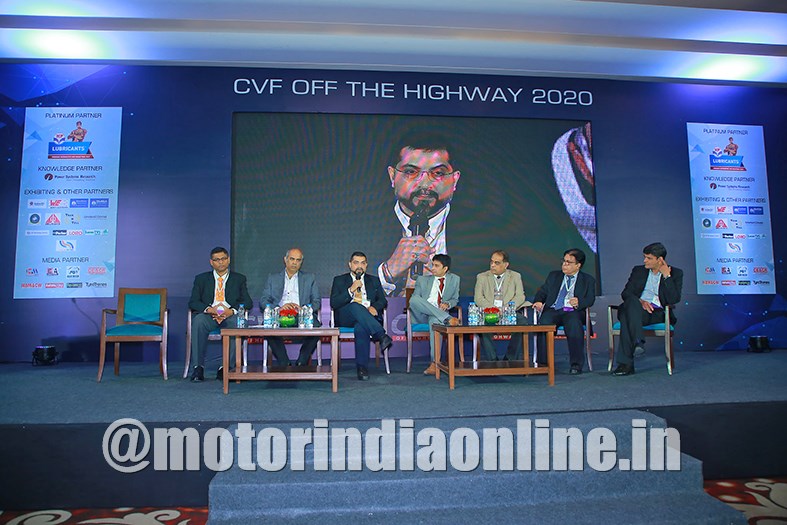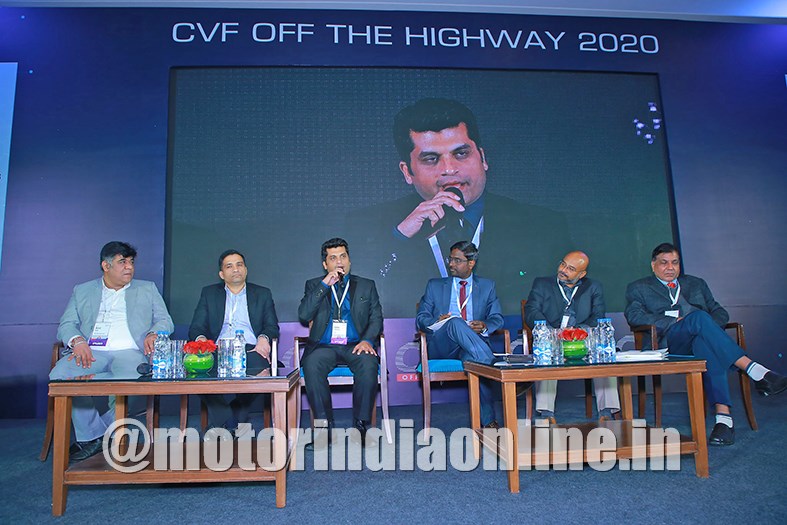The first edition of Commercial Vehicle Forum devoted to conversations on off-highway equipment segments discoursed on a series of issues and megatrends of critical importance to construction, earthmoving, mining, industrial, and agricultural equipment market in the country. An exclusive report by Dhiyanesh Ravichandran.

The off-highway equipment market is an intricate space to understand, precisely because of its cyclic nature that is prone to sharp swings in demand. For instance, when the construction and mining activities escalate in the country, sales pick up instantly resulting in prolonged lead times, as the manufacturers struggle to meet the orders. When the activities slow down, demand for new equipment drop sharply as contractors and rental firms can manage with the existing parc of equipment. At present, the Indian equipment market is caught in an intricate scenario wherein despite the fair level of construction activities being announced in the country, the equipment sales are witnessing a strong de-growth, with negative sentiments prevailing in the market since last year.
The domestic equipment market enjoyed a remarkable surge from 2016 to 2018 owing to an infrastructure boom, but a series of disruptions erupted to dampen the positive growth, including that of last year’s general elections, a wide-open liquidity crisis across the sectors of the economy, and so on. Yet, long-term prospects in the country are predicted to be extremely positive, aided by further sophistication and diversification of product lines and value-addition by connected technologies. In this backdrop, Commercial Vehicle Forum – a unique independent platform for senior executives of top concerns and industry experts – ventured for the first time to deliberate on developments and issues facing the Indian off-highway equipment markets. It took place on January 23 this year at Gurgaon.
Market outlook
The forum began with a detailed report on the larger scenario and prospects of the Indian off-highway industry, presented by Jinal Shah, Regional Director – South Asia Operations, Power Systems Research. He delineated the key challenges faced by the off-road equipment market that are converging at this point, followed by critical trends impacting the industry including specialised equipment, stringent emission norms, engine down-sizing, connected technologies, rental or leasing models, shifting focus to TCO, improvements in operator safety and comfort, and hybrid or electrification.

He also delved on how the upcoming CEV-TREM IV emission norms are going to pan out for all product segments. “This would lead the domestic market to advanced products on par with global standards, although customers may be wary of price hikes to the tune of 5-10 per cent. Concerns for aftermarket serviceability and maintenance will remain to be a challenge”, Shah noted. A series of panel discussions on themes such as market outlook, connected technology offerings, aftermarket importance, emission standards, and consumer behaviour kept the off-highway forum engaged for the whole day.
“The growth story of the Indian CE industry is full of ups and downs since the beginning”, said Anil Bhatia, Vice President Sales and Marketing, TIL Ltd., while adding that the current crisis is bound to clear away with the ease in availability of finances to consumers. On the role of the equipment industry in India’s USD 5 trillion economy dream, JCB’s Vice-President (Purchase) Gunjan Malhotra pointed out that the flow of equity into the industry and financing of construction and infra projects is important. “Yet another crucial question is on the product spectrum available in the domestic market. To propel the optimum level of growth and revenue in the industry, we need to move towards higher-tech sophistication and improved productivity out of our machines”, he added.
The CE industry is at a point where the stakeholders are ‘cautiously optimistic’ in the short and medium-term, but ‘aggressively optimistic’ over the long-term prospects, agreed the forum speakers. Sharwan Agnihotri, Head Exports and Corporate Sales, Hyundai Construction Equipment India, brought out three major challenges behind the current de-growth in equipment sales. “Slow announcement of infra projects by governments, withholding of such funding by state governments, and the NBFC liquidity crisis that has resulted in poor credit availability for end customers.
Aftermarket trends
In a panel discussion on trends in off-highway aftermarket moderated by Dhiyanesh Ravichandran, Senior Correspondent, representing MOTORINDIA – an associate partner of the forum, the panelists discussed on the rapid liberalisation of the market, with more and more players stepping into aftermarket activities including OEMs, along with changing technologies, and shifting consumer habits and business models. Country Head of Vermeer Equipment India, R. Thiagarajan, observed: “Over the last decade or so, there is an attitudinal change in aftermarket approach. It is no more about just servicing, but adding value to customer operations and building the life-cycle of equipment”.
Speaking on the vital role of rental companies in the aftermarket boom, Founder and Secretary General – CERA, Satin Sachdeva, said that with the emergence of specialised machines in the fleet of operators, the criticality of a robust and effective aftermarket ecosystem makes a huge difference. Rahul Sonawane, Head Sales & Services, Kamaz Motors, spoke on the emerging models of AMC packages from OEMs in the post-warranty period, wherein “the cost of both the manufacturer and the customer is fixed”. The speakers also took up the need for aftermarket businesses to stay competitive and equipped with the right skills and expertise, to prepare the industry for the years to come.
Connected technologies
Further, on consumer adoption of connected technologies and other advanced features, Puneet Vidyarthi, Director – Sales Construction Equipment, CASE New Holland, said that the owing cost of equipment and the technologies powering them will continue to drive the customer decisions on a larger scale, despite the restructuring of the consumer base towards corporations and big fleets in recent times. “The onus, therefore, remains on the OEMs to communicate the benefits of these technologies on the productivity and efficiency of operations”, he added. “All those parameters that matter to operators like fuel consumption or other technical stats are to be monitored and reviewed. Leveraging these data sets for further analysis is key to operational efficiency”, said Siddharth Chaturvedi, Head of Marketing & Product Development, Tata Hitachi.
Lastly, the panel moderated by Hetal Gandhi, Director, CRISIL Research, conversed on the key opportunities and challenges ahead with the stringent CEV-TREM IV emission norms for off-highway diesels effective from October 2020. Another panel discussion on consumer behaviour dealt with key factors influencing buyers’ preferences and decisions, along with the efficacy of TCO considerations in the Indian market. The next edition of CVF Off-Highway is scheduled for December 17, 2020 at Gurgaon.